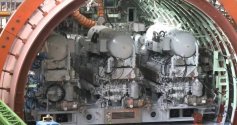I think people may be trying to read too much into the lull in warship construction and are missing the obvious - competition is exceptionally fierce in China, and in recent years, with commercial shipping orders already fallen off a cliff before the pandemic, naval orders are seen as a massive deal and vital revenue source.
As such, I would be amazed if all the shipyards were not all actively competing against each other to deliver their orders earlier than contractually required while also maintaining quality to put themselves in the best position possible to secure a bigger share of the next batch of naval orders.
That would explain a lot of the anomalies we have seen over the years, like finished ships spending unusually long periods tied up at the shipyards before delivery and commissioning, uneven allocation of warship orders between yards and this current lull in construction.
Once the next batch of orders are confirmed and if we see yet more and maybe even more pronounced uneven allocation of orders, then I think we can have a good guess at which shipyard won the race.
Pandemic and post pandemic we are seeing a huge surge of orders, at times over 200% over pre-pandemic period. Slots after slots are being reserved, and this is going to particularly impact Jiangnan because this is the go to place for top end commercial shipping such as containerships, RO-RO and LNG carriers. While they will still continue to build warships, its likely the proportion of it would be less than other shipyards. For instance we should expect a greater proportion of destroyers, both 052D and 055 to be built now in Dalian than in Jiangnan. Dalian's commercial speciality lies in oil tankers, but they can use the dock that was used for the Liaoning and Shandong for that, while the other dock that we have seen used for destroyer production will be used for the destroyers.
You cannot cut back on those commercial ship building either. These ships, whether they are owned by Chinese liners or not, serve the arteries of China's import and export economy.
Hudong Zhonghua also has their share of commercial ship orders, mainly LNG carriers, but they are built in the Changxing Island facility, not on the Huangpu River facility. The Huangpu River facility, which was supposed to be sold to real estate developers, now looks less and less likely that this may go through given the Chinese gov's deliberate bursting of the real estate companies bubbles. I would expect this to continue to build frigates, LPDs and LHDs in the coming years.
One thing I don't expect a cutback is Jiangnan building submarines. There appears to be a separate shed for this so it does not occupy the main building slots. I am expecting mass production of "039C" from both Wenchong and Jiangnan.
What we have previously seen as finished ships lying in dock for months in Dalian, is more an issue of the PLAN's side, with them not ready to adopt these ships. Most of Dalian's 052D output were going to the 10th Destroyer Division, which was doing a huge transition from Ludas to 052D, so that's a leap in training. But once the 10th settled, the 052Ds started pouring in for them.
With Dalian made 052D and 055 now being tested and quality affirmed by different destroyer divisions in the PLAN, I would expect full confidence on Dalian to go through a full batch production as the PLAN loosens the spigot.

